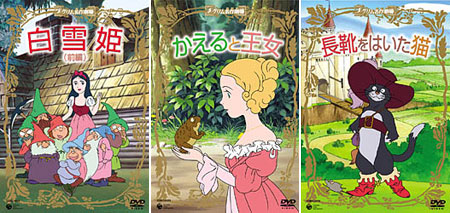Ask John: Why Aren’t More Anime Based on Fairy Tales?

Question:
Why are there not more anime titles based off of fairy tales? I don’t mean magical realms, but real fairy tales. It would seem there would be many anime based off of classic stories.
Answer:
Your theory is more accurate than you seem to realize. Traditional fairy tales are indeed a fertile source for anime adaptation, and there are probably more anime based on classic fairy tales than many American anime fans realize. I may be familiar with more anime titles than many American fans are, but I’m not aware of every anime. So I can provide some examples of anime based on classic fairy tales, but no matter how many examples I list, I’m sure that there will be some that slip by me.
The earliest known Japanese animated adaptation of a fairy tale is Seitaro Kitayama’s 1918 adaptation of the classic Japanese version of the Rip Van Winkle fable, “Urashima Taro.”
The Japanese “Momotaro” fairy tale also appears in both early and modern anime. The “Sora no Momotaro” (Momotaro’s Sky Adventure) short premiered in 1931. Director Mitsuyo Seo’s World War II propaganda film, “Momotaro no Umiwashi” (Momotaro’s Sea Eagles), loosely based on the Momotaro legend, was released on March 25, 1943, and was followed by the longer “Momotaro Umi no Shimpei” (Momotaro’s Divine Sea Warriors), which premiered on April 12, 1945. In the years since, the Momotaro legend has appeared in contemporary anime such as Risky Safety and Eto Rangers, and been adapted in the interactive anime Dancing Blade (which also adapted the Urashima Taro fairy tale), and the 1989 Momotaro Densetsu television series.
The ancient Japanese fairy tale “Taketori Monogatari” (Tale of the Bamboo Cutter), also known as “Kaguya-hime no Monogatari” (Tale of Princess Kaguya) has appeared in or inspired numerous anime including Tsukihime, the second Inuyasha movie, the Sailor Moon S movie, and Oh! Edo Rocket.
In March 1968 Toei released its feature film “Andersen Monogatari,” adapting fairy tales by Hans Christian Andersen. Mushi Productions created a 52 episode TV series version of “Andersen Monogatari” in 1971. Toei again adapted an Andersen fairy tale for its 1975 feature “Andersen Dowa: Ningyo Hime” (Andersen Story: The Mermaid Princess) better known as “The Little Mermaid.” Toei continued its series of fairy tale adaptations with the 1977 film “Hakuchou no Ouji” based on Andersen’s “The Wild Swans”; the 1978 film “Oyayubi Hime” based on Thumbelina; the 1980 film “Mori wa Ikiteiru” based on the Russian fairy tale “The Twelve Months” by Samuil Yakovlevich Marshak; and the 1982 film “Aladdin to Mahou no Lamp” (Aladdin and the Magic Lamp).
In March 1969, Toei released “Nagagutsu wo Haita Neko,” its feature film adaptation of Charles Perrault’s fairy tale “Puss ‘n Boots.” The story was again animated in 1992 as the television series “Fantasy Adventure: Nagagutsu wo Haita Neko no Boken” (Fantasy Adventure: The Adventure of Puss in Boots).
In 1974 animation studio Group TAC, better known these days for anime series including Black Blood Brothers and Grenadier, produced a feature length “Jack to Mame no Ki” (Jack and the Beanstalk) feature film. (Many American anime fans may be surprised to know that this film is available on bilingual American DVD from Henstooth Video.) Acclaimed animation auteur Koji Morimoto also produced a short anime film version of Jack and the Beanstalk in 1993.
The popular 1975 television series “Manga Nihon Mukashi Banashi” (Manga Japanese Fairy Tales) was re-broadcast on Japanese television in 2005. While that series concentrated on Japanese fairy tales, the 1976 television series “Manga Sekai Mukashi Banashi” (Manga Fairy Tales of the World) expanded its focus to international stories and lasted through 127 episodes.
The fairy tales of the Arabian Nights have been adapted into anime several times. Toei produced the feature film “Arabian Night: Sinbad no Boken” (Arabian Night: Adventures of Sinbad) in 1962. Nippon Animation produced a television series with the same title in 1975. Osamu Tezuka’s Mushi Productions released the “Senya Ichiya Monogatari” (1,001 Nights Story) feature film in June 1969. The 1,001 Nights was later animated in a 1998 artistic and expressionistic short film based on the art of painter Yoshitaka Amano.
Aesop’s fables were animated in the 1983 television series “Manga Aesop Monogatari” (Manga Aesop’s Fables) and again in 1999 in the “Aesop’s World” television series.
The Grimm brothers’ fairy tales were used as the source for the 1987 “Grimm Meisaku Gekijou” (Grimm Masterpiece Theater) television series and its 1988 sequel “Shin Grimm Meisaku Gekijou” (New Grimm Masterpiece Theater). American fans may recall this anime series from its 1989 broadcast on the Nickelodeon cable network as “Grimm’s Fairy Tale Classics.”
Cinderella became an anime courtesy of Tatsunoko Productions’ 1996 television series “Cinderella Monogatari” (Cinderella Story).
The “Ugly Duckling” fairy tale served as the foundation for the 2002 Princess Tutu television series.
Over the years, the Hello Kitty anime franchise has produced countless episodes and OVAs based on a variety of Japanese and international fairy tales, including Cinderella, Snow White, and Momotaro.
As I mentioned, this list may seem surprisingly long, but I have little doubt that there are absentees from this list that I’m not aware of. I’ve also consciously excluded titles like Akazukin Chacha, Dragonball: Sleeping Beauty in Devil Castle, Jin-Roh, and Cinderella Boy that draw inspiration from fairy tales, but aren’t remotely adaptations of fairy tales. International anime fans may have the impression that there are few anime based on classic fairy tales simply because there haven’t been any anime recently that have adapted fairy tales.
Add a Comment
You must be logged in to post a comment.


I think exist a lot of anime based in fairy tales, but Japan have thier own mythology and don’t need a lot the stories about western fairies.
And, a huge number of fairy tales are best knows for the Disney’s adaptation, so maybe anime producers are not interested in make anime about stories that Disney adapted before.